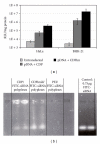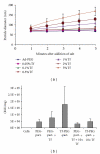Cyclodextrin-containing polymers: versatile platforms of drug delivery materials
- PMID: 22496980
- PMCID: PMC3307009
- DOI: 10.1155/2012/262731
Cyclodextrin-containing polymers: versatile platforms of drug delivery materials
Abstract
Nanoparticles are being widely explored as potential therapeutics for numerous applications in medicine and have been shown to significantly improve the circulation, biodistribution, efficacy, and safety profiles of multiple classes of drugs. One leading class of nanoparticles involves the use of linear, cyclodextrin-containing polymers (CDPs). As is discussed in this paper, CDPs can incorporate therapeutic payloads into nanoparticles via covalent attachment of prodrug/drug molecules to the polymer (the basis of the Cyclosert platform) or by noncovalent inclusion of cationic CDPs to anionic, nucleic acid payloads (the basis of the RONDEL platform). For each of these two approaches, we review the relevant molecular architecture and its rationale, discuss the physicochemical and biological properties of these nanoparticles, and detail the progress of leading drug candidates for each that have achieved clinical evaluation. Finally, we look ahead to potential future directions of investigation and product candidates based upon this technology.
Figures










Similar articles
-
Linear cyclodextrin-containing polymers and their use as delivery agents.Expert Opin Drug Deliv. 2006 Sep;3(5):641-6. doi: 10.1517/17425247.3.5.641. Expert Opin Drug Deliv. 2006. PMID: 16948559 Review.
-
Polymeric Nanoparticles in Gene Therapy: New Avenues of Design and Optimization for Delivery Applications.Polymers (Basel). 2019 Apr 25;11(4):745. doi: 10.3390/polym11040745. Polymers (Basel). 2019. PMID: 31027272 Free PMC article. Review.
-
Engineering responsive polymer building blocks with host-guest molecular recognition for functional applications.Acc Chem Res. 2014 Jul 15;47(7):2084-95. doi: 10.1021/ar5001007. Epub 2014 Apr 17. Acc Chem Res. 2014. PMID: 24742049
-
Fe3O4 nanoparticles modified by CD-containing star polymer for MRI and drug delivery.Colloids Surf B Biointerfaces. 2017 Oct 1;158:213-221. doi: 10.1016/j.colsurfb.2017.06.049. Epub 2017 Jun 30. Colloids Surf B Biointerfaces. 2017. PMID: 28697436
-
Targeted Drug Delivery with Polymers and Magnetic Nanoparticles: Covalent and Noncovalent Approaches, Release Control, and Clinical Studies.Chem Rev. 2016 May 11;116(9):5338-431. doi: 10.1021/acs.chemrev.5b00589. Epub 2016 Apr 25. Chem Rev. 2016. PMID: 27109701 Review.
Cited by
-
Nanoparticles in the ocular drug delivery.Int J Ophthalmol. 2013 Jun 18;6(3):390-6. doi: 10.3980/j.issn.2222-3959.2013.03.25. Print 2013. Int J Ophthalmol. 2013. PMID: 23826539 Free PMC article.
-
Targeted Delivery Methods for Anticancer Drugs.Cancers (Basel). 2022 Jan 26;14(3):622. doi: 10.3390/cancers14030622. Cancers (Basel). 2022. PMID: 35158888 Free PMC article. Review.
-
First-in-human, phase I/IIa study of CRLX301, a nanoparticle drug conjugate containing docetaxel, in patients with advanced or metastatic solid malignancies.Invest New Drugs. 2021 Aug;39(4):1047-1056. doi: 10.1007/s10637-021-01081-x. Epub 2021 Feb 16. Invest New Drugs. 2021. PMID: 33594602 Clinical Trial.
-
Mind the gap: a survey of how cancer drug carriers are susceptible to the gap between research and practice.J Control Release. 2013 Dec 28;172(3):1045-64. doi: 10.1016/j.jconrel.2013.09.026. Epub 2013 Oct 2. J Control Release. 2013. PMID: 24096014 Free PMC article. Review.
-
Targeting Genetic Modifiers of HBG Gene Expression in Sickle Cell Disease: The miRNA Option.Mol Diagn Ther. 2022 Sep;26(5):497-509. doi: 10.1007/s40291-022-00589-z. Epub 2022 May 12. Mol Diagn Ther. 2022. PMID: 35553407 Free PMC article. Review.
References
-
- Davis ME, Brewster ME. Cyclodextrin-based pharmaceutics: past, present and future. Nature Reviews Drug Discovery. 2004;3(12):1023–1035. - PubMed
-
- Veronese FM, Pasut G. PEGylation, successful approach to drug delivery. Drug Discovery Today. 2005;10(21):1451–1458. - PubMed
-
- Cheng J, Khin KT, Jensen GS, Liu A, Davis ME. Synthesis of linear, β-cyclodextrin-based polymers and their camptothecin conjugates. Bioconjugate Chemistry. 2003;14(5):1007–1017. - PubMed
-
- Cheng J, Khin KT, Davis ME. Antitumor activity of beta-cyclodextrin polymer-camptothecin conjugates. Molecular Pharmacology. 2004;1(3):183–193. - PubMed
-
- Schluep T, Gunawan P, Ma L, et al. Polymeric tubulysin-peptide nanoparticles with potent antitumor activity. Clinical Cancer Research. 2009;15(1):181–189. - PubMed
LinkOut - more resources
Full Text Sources
Other Literature Sources
Research Materials

